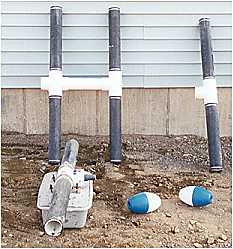
 xperiments
on wastewater aeration started in England as early as 1882. They continued on
aeration and aerated filter wastewater treatment in England and the U.S. until
the activated sludge process was unleashed to the world in April of 1914.
xperiments
on wastewater aeration started in England as early as 1882. They continued on
aeration and aerated filter wastewater treatment in England and the U.S. until
the activated sludge process was unleashed to the world in April of 1914.
In the early experiments, air was introduced through open tubes or perforations.
As the activated sludge process investigation progressed, greater economy was
sought with smaller bubbles produced by porous media. In 1914, experiments were
made with natural limestone, fire brick, sand and glass mixtures, pumice and
other materials. They were all found to be to dense. In 1915 a porous plate set
in a cast iron box was developed. In the following years, experiments with
porous media and other media continued.
Diffuser clogging was a problem in numerous cases from the earliest aeration
experiments. Around 1915, perforated pipes were abandoned in favor of diffusers
because 90% of the jets had plugged. With the advent of porous diffusers,
clogging became an even greater problem. Early work between 1922 to 1924
prompted coarser media use to avoid severe clogging problems.
Mechanical aeration was one answer to the clogging problem. Down draft and up
draft type mechanical aerators were developed to diffuse air efficiently and to
solve clogging problems.
Another approach to the clogging problem was the development of the large
orifice-type diffuser. First developed in the 1950's, these units improved on
earlier perforated pipes and were designer for easy maintenance and
accessibility. These devices generated larger bubbles and sacrificed substantial
transfer efficiency for maintenance ease.
With the emphasis on more energy efficient aeration systems in the 1970's, the
technology turned to fine bubble systems. Emphasis on fine pore diffusion has
lead to many extensive research programs aimed at the evaluation of design,
operation, and control processes relative to improving overall system
performance.
|
 |
|
Fine bubble diffusers shown mounted on a tub of ballast.
The surface floats allow the diffusers to be pulled to the top
of the water surface for maintenance.
|
Lagoon Aeration Fundamentals and Techniques

